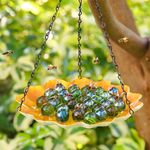How to Plant an Easy-to-Water Strawberry Jar
The trick is using plastic pipes to deliver moisture where it’s needed

Many gardeners who have tried to use a strawberry jar for patio plantings have been frustrated by the challenge of keeping it evenly moist. Most jars are made of clay, which tends to dry out easily, and they are usually filled with sun-loving plants and positioned in the sunniest (and therefore fastest-drying) spot in the garden. The design of the strawberry jar creates one additional problem: the seeming impossibility of getting water, which wants to run downhill, out to the sides of the container where the plants’ roots are.
You can solve this problem by taking advantage of the law of physics that says that water will run downhill until it meets an obstruction. The trick is to create vertical irrigation pipes from which water will ooze out horizontally.
To determine the size of PVC pipe you’ll need, measure the height of your container and the diameter of the opening at the top. If you want to use several small plants in the top opening, choose a pipe that is approximately a quarter of the diameter of the top opening. You can figure this out by tracing the opening of the jar on a piece of paper and taking the paper to the store with you. Take a section of pipe, and stand it in the center of the tracing. If it seems like there’s enough room left to fit some small plants around it, you’ve found the right size. On the other hand, if you want to center a large plant at the top, use three smaller pipes instead, and place them close to the rim for a larger planting space.
The pipe should be 1 to 2 inches shorter than your container is tall. You can have it cut at the store, or you can cut it yourself at home with a hacksaw. A cork or sink stopper fit snugly into the end of the pipe will keep water from draining out of the bottom.
Strawberry jars are often planted with herbs, so here’s an idea for an herb combination using some of the more ornamental varieties. For the top of the jar, choose an upright rosemary (Rosmarinus officinalis and cvs., USDA Hardiness Zones 8–11) and underplant it with ‘Kent Beauty’ oregano (Origanum ‘Kent Beauty’, Zones 5–8), an ornamental oregano featuring hoplike bracts. Or pick a lavender (Lavandula spp. and cvs., Zones 5–9) and underplant it with a prostrate variety of rosemary.
In the pockets, you could plant some of the more unusual thymes, like lemon (Thymus × citriodorus and cvs., Zones 6–9), nutmeg (T. praecox subsp. arcticus, Zones 5–9), lavender (T. thracicus, Zones 5–9), or caraway (T. herba-barona, Zones 6–9). Use winter savory (Satureja montana, Zones 5–8), tarragon (Artemisia dracunculus, Zones 3–7), and ‘Tricolor’ sage (Salvia officinalis ‘Tricolor’, Zones 5–8) to fill the remaining pockets.
Materials
|
|
Step 1
After cutting the pipes to a length slightly shorter than the height of the strawberry pot, drill holes on all sides of the pipes, all the way along their length. Drill fewer holes in the ends that will be near the bottom of the pot.
Step 2
Jam a cork into the bottom end of each pipe. If necessary, slice the cork off with a knife so that it is flush with the pipe; that way, the pipe will stand up straight without wobbling.
Step 3
Hold the pipes in position while you add moistened potting mix up to the bottom of the lowest pocket. If you use only one pipe, place it slightly off center so that it doesn’t block the drainage hole.
Step 4
Squeeze the soil around the root ball of each plant so that it will fit into a planting pocket. Working from the outside in, snuggle the root ball into the pocket, then reach inside and spread out the roots. Pat potting mix over the roots, and continue adding it until it is level with the bottom of the next pocket. Continue this process to the top of the pot.
Step 5
When the pot is fully planted, pour water directly into the pipes. Because the bottom is blocked, the water will have nowhere to go but out through the holes and sideways toward the plants—right where you want it.

1. ‘Goodwin Creek Grey’ lavender (Lavandula ‘Goodwin Creek Grey’, Zones 7–10)
2. Lemon verbena (Aloysia triphylla, Zones 8–11)
3. Get Mee® Purple campanula (Campanula portenschlagiana Get Mee® Purple, Zones 3–8)
4. ‘Tricolor’ sage (Salvia officinalis ‘Tricolor’, Zones 5–8)
5. Curly mint (Mentha spicata var. crispa, Zones 3–7)
Maggie Stuckey is co-author of the book McKee & Stuckey’s The Bountiful Container.
Photos, except where noted: Wendy Bowes
Fine Gardening Recommended Products

Bee Watering Station with Vivid Flower Design
Fine Gardening receives a commission for items purchased through links on this site, including Amazon Associates and other affiliate advertising programs.

Chapin International 10509 Upside-Down Trigger Sprayer
Fine Gardening receives a commission for items purchased through links on this site, including Amazon Associates and other affiliate advertising programs.

Gardena 3103 Combisystem 12-Inch To 20-Inch Adjustable Metal Fan Rake Head
Fine Gardening receives a commission for items purchased through links on this site, including Amazon Associates and other affiliate advertising programs.











Comments
Log in or create an account to post a comment.
Sign up Log in